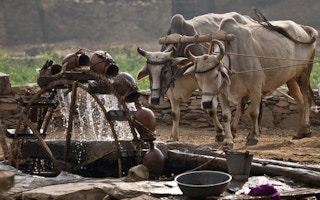India has a novel idea: Wean farmers from archaic power lines and expensive diesel fuel to run their water pumps with solar energy.
The government is looking to swap 26 million groundwater pumps for more efficient irrigation models powered by the sun. If successful, crop production could rise in India, where farms suffer from blackouts and volatile fuel costs. It would also save about $6 billion a year in power and diesel subsidies.
Companies targeting the market include BlackRock Inc- backed SunEdison Inc, Asia’s top irrigation-equipment maker Jain Irrigation Systems Ltd. (JI) and Claro Energy Pvt., whose investors include Standard Chartered Plc Managing Director Arun Singhal.
“
Asia’s second-most populous nation will draw 100 billion rupees ($1.6 billion) of investment in the next five years as the first 200,000 most easily replaceable pumps are switched to solar, the government estimates
“The potential is huge,” Tarun Kapoor, joint secretary at India’s Ministry of New and Renewable Energy, said in an interview. “Irrigation pumps may be the single largest application for solar in the country.”
Asia’s second-most populous nation will draw 100 billion rupees ($1.6 billion) of investment in the next five years as the first 200,000 most easily replaceable pumps are switched to solar, the government estimates. That will relieve an overburdened power-transmission grid built mostly in the 1960s that’s prone to failures.
A risk in converting to solar pumps is that farmers may use excessive amounts of water because the devices have almost no operating costs. To avoid that, farmers must use water-saving drip irrigation in exchange for accepting subsidies to buy solar water pumps.
One who has already seen the benefits of switching over is OVR Somasundaram, a 67-year-old who grows coconuts, nutmeg and cocoa in southern India. He invested two years ago in a solar pump from St. Peters, Missouri-based SunEdison.
Snake-bite risk
Somasundaram’s 75 acres of farmland in Coimbatore, Tamil Nadu, used to be dependent on electricity from the state, sometimes only available four hours a day from an antiquated grid. When the power came on, it was often at night, meaning workers risked snake bites as they wandered into dark fields.
“Crops need water,” he said in an interview in Chennai. “My crops would have failed if I hadn’t opted for a solar pump.”
Somasundaram now gets water when he needs it, throughout the year when the sun is out, and without the fuel costs of a diesel generator. He irrigates a third of his holdings with the system, which cost 400,000 rupees after 60 percent was subsidized.
‘Break link’
The new water reliability from a technology that moves away from older energy sources will allow him to plant an extra crop, black peppers. About 3,000 saplings are to be sowed by March.
Using fossil fuel-based power to pump well, canal and farm water also contributes to climate change, said Aaron Mandel, founder of WaterFX, which sells solar desalination technology.
Let’s “break the link between carbon-based fuels and additional water production,” Mandel said. “The best way to do this is for the water industry to begin to take advantage of the cost reductions that have already occurred in renewable energy.”
The cost of photovoltaic panels that have slumped by half since 2010 and government subsidies mean the payback period of a solar pump system is one to four years, said Ajay Goel, chief executive officer of Tata Power Solar Systems Ltd, a panel maker and project contractor belonging to Tata Group, India’s biggest industrial holding.
Eliminate subsidies
The government funds in some states as much as 86 per cent of the cost of solar pump systems that in the long run save money because they eliminate $6 billion in annual farm diesel and electricity subsidies, according to Kapoor. That aid helped nudge India’s current-account deficit to a record last year.
The economics will only get better as diesel prices rise and scale brings more efficiencies, eliminating the need for state support, said Stephan Grinzinger, head of sales for Lorentz Vertriebs GmbH, a German maker of solar water pumps.
“Because of the drop in photovoltaic prices, globally we’re selling more solar pumps without subsidies than with,” Grinzinger said.
The change comes as production of mainstay crops like wheat, corn and rice stagnate in India, according to a 2012 study of nearly five decades of yield data published by the journal Nature Communications. The reasons included water scarcity and falling groundwater tables.

















